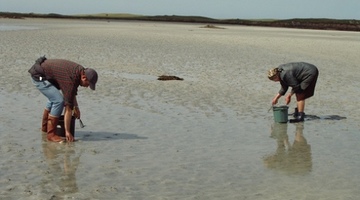Ecologists often look for places where the environment has been changed in order to test out ideas about how the environment influences food webs. In this video, Associate Professor Stephen Wing, from the University of Otago, discusses his research into the impact of freshwater from a hydroelectric plant on cockle populations in Fiordland.
Point of interest
Think about what might happen if cockles were removed from New Zealand marine food webs. What organisms might be affected?
Transcript
Associate Professor Stephen Wing
In Doubtful Sound, there is a hydroelectric power plant that dumps water out of Lake Manapōuri down a series of tunnels to turbines that turn and generate electricity. Because of the freshwater input in Deep Cove, the shallow water environment is quite different than in other places in the fiords, so it’s not as good for supporting cockles. There aren’t the big beds of cockles there used to be. And so that created a real opportunity as an ecologist to learn what happens when you remove cockles, in terms of what happens to the whole food web. First, we investigated what the environment was like before the power plant went in. We found out that it used to be a lot more saline or a lot more salty than it is now. But what we wanted to know was whether conditions used to be appropriate for cockles to live there, and we found out that they were. And we worked out that the population of cockles in that area is reduced from similar areas around it. And then we looked at some of the consumers of cockles and other bivalves – things like mussels – and we found out that the lobsters had switched their diet, in the inner parts of Doubtful Sound, to a completely different source – a little clam that lives down in the deep basins that actually gets none of its energy from primary producers, and it gets all of its energy from bacteria. The implications for the food web are that the food web is different. The energy that is coming in to the food web comes from a different source, and that source is smaller than the primary producers that get their energy from sunlight. And so what it means is there is less energy to support a big population of crayfish in that inner part because the cockles, which provided a link to phytoplankton and macroalgae – kelps and things like that – are missing. So they are not doing their job in the food web, and so their job is being done by a different source that’s smaller, harder to get at and is not as productive – it doesn’t produce as much energy. If you removed cockles from a marine food web, it would have dramatic effects on all the consumers, all of the animals that rely on their services. And we can guess that for New Zealand, but we know that from some systems where this has actually happened. And so there are several places around the world where there have been huge die-offs of bivalves – mussels and clams and so on. This has had effects all the way up through the food web to the highest levels, to seabirds that feed on little cockles or little clams, to sharks and large fish. So when you disturb a food web, at any place but particularly near the bottom, this can have sort of reciprocating effects all the way up through.
Acknowledgements:
Barbara Agnew
Creative Commons
Ian McHenry
Ian Skipworth
MarineNZ, www.marinenz.org.nz
Rob Young
Robert Newell



